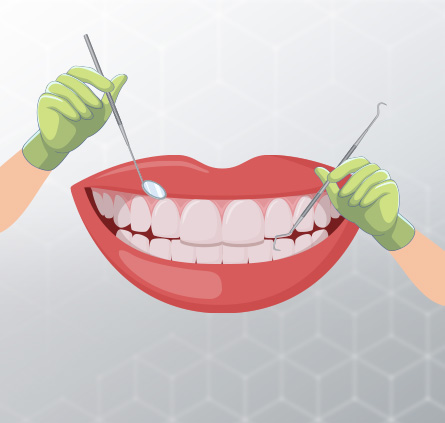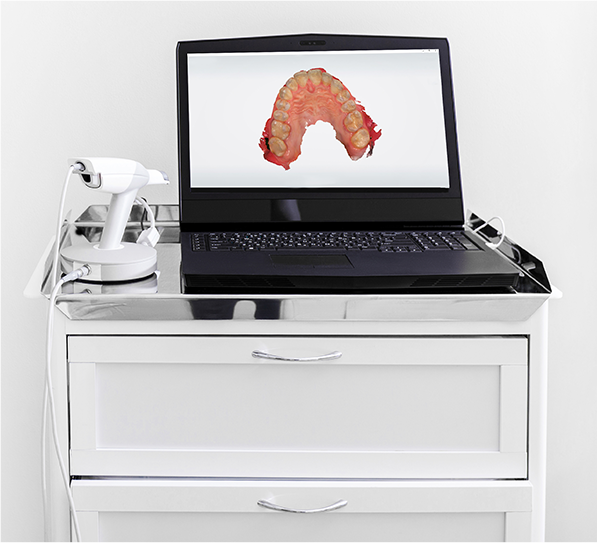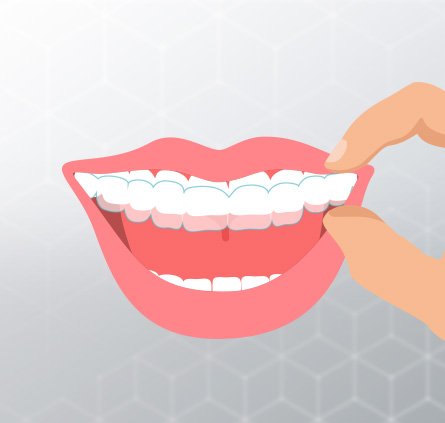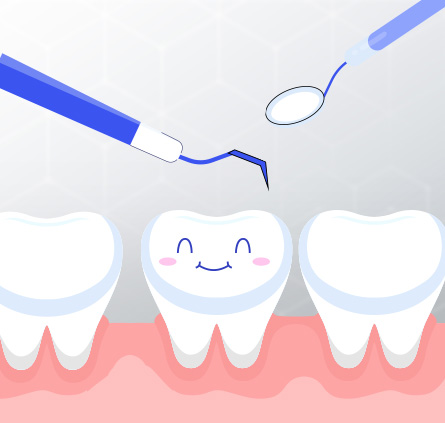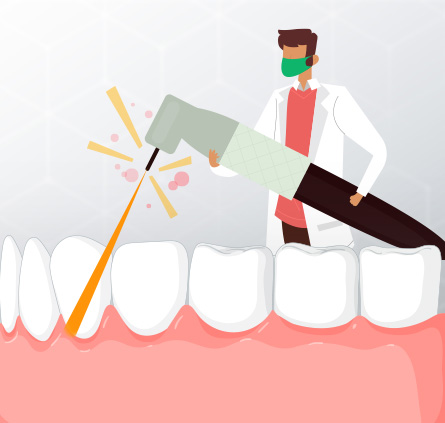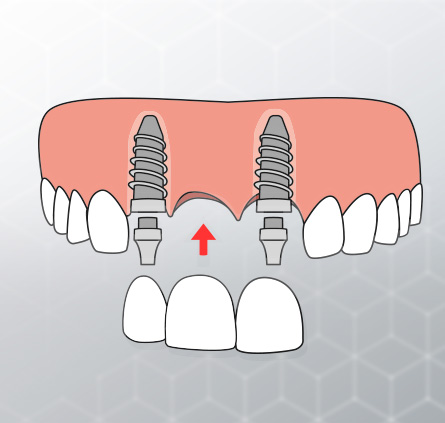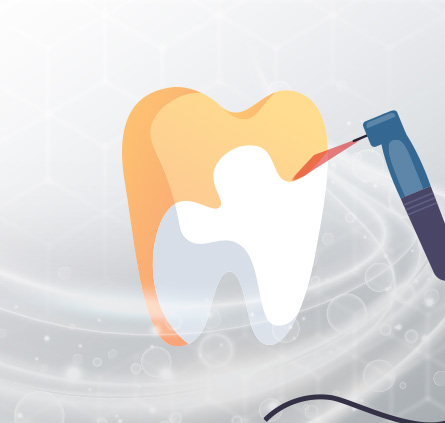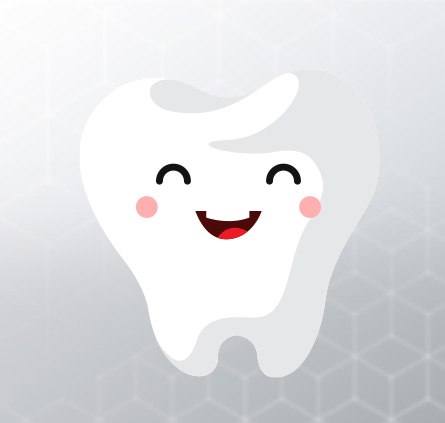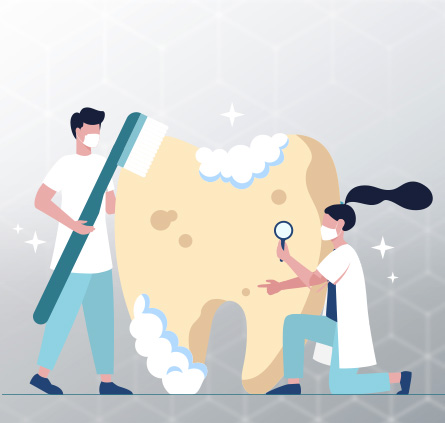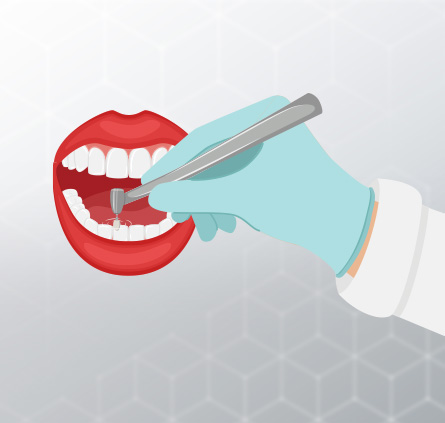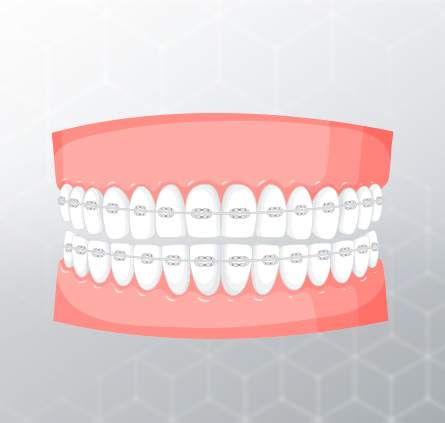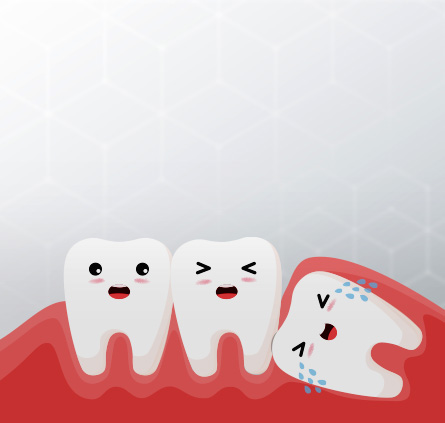Dental Checkup With Intra Oral Scanner
The importance of regular dental check-up cannot be stressed enough. It allows us to detect any changes in
the oral cavity and treat maladies at their inception. This is the simplest and most effective mode of
dental treatment. If done thoroughly and efficiently, a good dental check-up can detect problems before they
become severe and painful.
We at Health Chakra, believe in utilizing the latest technology, to give our patients the best in preventive
and treatment modalities. For this reason, an intra oral scanner is used to scan the entire mouth. This
helps us to view the oral cavity, from all angles effectively. A three-dimensional scan, visible on a big
screen, acts as a visual and diagnostic tool. This helps in early detection and diagnosis. It also helps the
doctor and the patient to keep a record of dental health for future comparison and reference. It becomes
very easy for the patient to view their oral cavity, helping them understand and participate better in their
own oral care.
Smile Designing
Smile Designing is a cosmetic dental procedure aimed at enhancing the appearance of your smile through a range of treatments such as teeth whitening, aesthetic fillings, dental veneers, anterior crowns, dental implants, and orthodontic solutions like aligners. It is ideal for individuals dealing with issues like tooth decay, discoloration, gaps, misalignment, gummy smiles, missing or broken teeth, wear due to aging, or any other concerns that affect their confidence in their smile.
The goal is to create a naturally beautiful, bright, and well-aligned set of teeth that enhances your overall appearance. Our expert team–including Cosmetic Dentists, Prosthodontists, Implantologists, and Orthodontists–conducts a thorough evaluation, followed by a digital scan. Based on this, a fully personalized treatment plan is designed to achieve a complete smile transformation. The results often lead to significant improvements not only in facial aesthetics but also in self-esteem and confidence.
Dental Aligners
Dental aligners are clear, custom-made trays crafted from a specialized silicone-based material designed to straighten teeth discreetly. Unlike traditional braces, aligners offer a more aesthetic and comfortable alternative, applying consistent, gentle pressure to shift teeth into their ideal positions–without the need for metal brackets or wires. Created using precise digital scans, these aligners are tailored to each individual. Suitable for people of all ages, they are nearly invisible when worn, making them a popular choice for those seeking a subtle and convenient orthodontic solution.
Procedure
Scan
Our team of orthodontists and cosmetic dentists begins by capturing a detailed digital scan of the jaws.
Process
The digital scan is then processed using advanced software that maps out the precise movements needed to align your teeth.
Simulation
A digital simulation is created to display the predicted movement of the teeth and the expected outcome, allowing patients to visualize their results before the treatment even begins.
Aligners
Before beginning the treatment, we provide you with a comprehensive plan that includes the estimated number of aligners required, the expected treatment duration, and any specific guidelines to follow.
Follow Up
The patient receives a series of aligners, each accompanied by clear instructions on how long it should be worn. A customized follow-up schedule is also planned based on individual treatment needs.
Painless Root Canal Treatment
Root Canal Treatment is a procedure performed to clean and disinfect a tooth where the infection has reached the innermost layer, known as the dental pulp. When the pulp becomes infected, it is crucial to remove the damaged or dead tissue to stop the infection from spreading to the surrounding gums and bone. Timely intervention helps preserve the tooth and prevents complications such as severe pain, swelling, or even the need for extraction if left untreated.
Procedure
Anaesthesia
Administration of local anaesthesia
Single sitting Root Canal Treatment
Our specialists utilize cutting-edge technology to ensure your Root Canal Treatment is completely atraumatic and comfortable.
Rotary Endomotors are used for cleaning the infected tissue. These advanced tools are faster and more efficient than traditional manual cleaning methods.
Laser disinfection is employed to eliminate 99.9% of the local bacteria, speeding up the healing process and ensuring a thorough cleaning.
These innovative techniques minimize discomfort both during and after the procedure. In fact, the entire treatment usually takes no more than 45 minutes!
Only a single dose of local anesthesia is needed, and the procedure is completed before it wears off, so you can relax and even take a quick nap while we take care of your tooth!
Laser gum treatment
Gum disease is a common issue that can lead to various complications, including bleeding gums, bad breath, exposed tooth roots, tooth loosening due to gum and bone infection, and even conditions like diabetes. In such cases, laser gum treatment can be highly effective.
One of the key benefits of using lasers is that they do not require cutting the gums. Lasers are used to target and remove harmful bacteria from the infected areas, promoting healing. The procedure is painless, and there is no need for anesthesia, making it a comfortable treatment option for patients.
Who needs gum treatment?
Anyone experiencing issues like bleeding gums, bad breath, loosening teeth, or gum swelling may require gum treatment. Certain conditions can contribute to weakened gums, including:
Diabetes
Hypertension – Many antihypertensive medications can cause gum swelling as a side effect
Hormonal changes – These can occur during pregnancy and menopause
PCOD (Polycystic Ovary Disorder)
Hypothyroidism
Trauma to the gums
These conditions can increase the risk of gum disease, making timely treatment essential for maintaining optimal oral health.
Laser gum treatment procedure
- Local Deposit Cleaning: Plaque and other local deposits are carefully removed using specialized instruments.
- Laser Application: The fiber optic tip of the laser is directed to the infected area for precise treatment.
- Bacterial Removal: The laser effectively disinfects both the surface and deeper layers of the gums, reaching up to the bone level. It targets and eliminates infected tissue while leaving the healthy tissue unharmed due to its high precision.
- Sealing the Area: One of the key advantages of laser treatment is its ability to promote blood clotting, sealing the area while disinfecting it. This results in no post-operative bleeding or discomfort.
Dental Crowns
A crown is essentially a protective cap placed over a damaged tooth. It can be crafted from various materials, such as metal or porcelain, depending on the location and aesthetic needs. For instance, you may have a crown on a molar, which is less visible unless you open your mouth widely, or on your front teeth, where crowns are designed to blend seamlessly with the natural appearance of your smile.
Dental Implants
Dental Implants are tooth-like metal posts designed to replace missing teeth, offering a permanent and fixed solution. They are widely regarded as the most effective alternative to dentures, which often don't fit well, and provide a reliable option when a lack of teeth makes traditional bridgework unfeasible.
Why Choose dental implants?
Tooth loss can occur for various reasons, such as gum disease, dental decay, or trauma, and it can lead to both functional and psychological issues. Missing teeth disrupt proper chewing and digestion, impair speech, and cause aesthetic concerns. Additionally, the absence of teeth causes neighboring teeth to shift, misaligning the entire jaw. This results in a cycle of further tooth loss due to the weakening of the surrounding teeth and bone.
Beyond the functional challenges, tooth loss can have significant psychological effects. The collapse of the cheeks, the formation of wrinkles, and a loss of confidence–especially when smiling–can impact both mental and physical well-being. Dental implants offer the most natural solution to replace lost teeth, providing a tooth-like, permanent restoration.
Procedure
- Comprehensive Evaluation: A full clinical and radiographic assessment is performed to plan the treatment.
- Medical History Review: Your medical history is carefully reviewed to ensure safety during the procedure.
- Anesthesia: General anesthesia is administered to ensure comfort during the procedure.
- Implant Site Preparation: A small hole is drilled into the jawbone.
- Placement of Implant Post: The implant post is inserted into the drilled area and embedded into the bone.
- Cover Placement: A cover is placed over the implant to protect it during healing.
- Healing and Integration: The bone undergoes healing, which can take from a few days to several months, depending on the individual’s healing process.
- Abutment Placement: Once the implant is fully integrated with the bone, an abutment (a connector piece) is placed.
- Final Prosthesis: A scan or impression of the area is taken, and a crown, bridge, or other prosthesis is placed to complete the restoration.
Zoom Whitening
Teeth Whitening is a simple yet highly effective cosmetic treatment designed to lighten discolored teeth. It's one of the most popular elective dental procedures due to its ability to deliver quick and noticeable results, enhancing your appearance and boosting your confidence.
we use the Philips Zoom Whitening system, which can brighten your teeth by up to 8 shades in just 45 minutes! One of the key benefits of this system is that it causes little to no post-treatment sensitivity.
Procedure
- Initial Assessment: Your dentist will take diagnostic pictures and scan your teeth to assess areas of concern and measure the level of whitening needed. Then, a thorough cleaning is performed to remove surface plaque and contaminants. A protective gel is applied to your gums, and the whitening gel is carefully applied to your teeth. The Zoom machine is then used to activate the gel, a process that typically takes 30 minutes.
- Post-Treatment Care: After whitening, the dentist uses a laser over the treated areas to seal in the results and minimize sensitivity. This step is essential for ensuring the longevity of the treatment and a polished finish.
- Final Result: You walk out with a noticeably brighter and more confident smile!
Child Dentistry
Children typically begin to develop their milk teeth around 6 months of age, and the full set of deciduous teeth is usually complete by 3-4 years. Since children require adult supervision for brushing and cleaning, it’s crucial to pay extra attention to their oral hygiene during this stage. Around the age of 6-7 years, children start losing their milk teeth, making way for the emergence of permanent teeth.
When should you start dental care?
The answer is as soon as your baby is born! While babies don’t have teeth at birth, they do have gum pads that need to be cleaned daily. This can be done using a silicon finger cover or sterile gauze. Once the first teeth emerge, it’s time to clean them with a pediatric toothbrush.
The best time for a first dental visit is at age 3. However, if the child develops cavities, blackened front teeth, swelling, or infections, an earlier visit may be necessary.
Paediatric dental treatment
-
Fillings
Children can develop small cavities that are best treated with tooth-colored fillings, especially if detected early. Regular check-ups are essential for catching these cavities before they progress and cause trauma.
-
Root Canal Treatment
Because children's teeth are soft, cavities can progress rapidly, sometimes leading to large infections overnight. While the idea of a root canal for your child may seem daunting, it is a safe and effective procedure that can save the tooth. It removes infection from the milk tooth and protects the underlying permanent tooth from infection before it erupts.
This simple procedure involves removing the infected tissue and filling the root with a resorbable material. A cap may be placed to ensure proper chewing and protect the tooth from further breakdown. Remember, milk teeth are essential for your child’s nutrition and jaw development–they need to be healthy for proper growth until around age 12.
-
Preventive Treatments
-
Pit and Fissure Sealants
For children with deep grooves in their molars or those prone to cavities, we apply a thin layer of sealant to protect the teeth from bacterial attack. No drilling is required, making this an excellent preventive treatment. Fun-colored sealants can motivate your child to stay engaged in their oral hygiene.
-
Fluoride Application
Fluoride strengthens enamel, making it more resistant to decay. During the dental visit, your child’s teeth will be treated with a fluoride gel that helps prevent cavities. This simple, non-invasive treatment can lead to strong, decay-free teeth for life when done at the right intervals.
-
Oral Hygiene Counseling
Our dental team will guide you on the best practices to maintain your child’s oral hygiene. We’ll discuss brushing techniques, dietary changes, and other tips tailored to your child’s specific needs.
-
Maxillofacial Appliances
For children with jaw growth issues or crooked teeth, preventive appliances can be created to reduce the need for future orthodontic or surgical treatments.
The Importance of Early Care
The earlier your child learns good dental habits, the better their long-term oral health will be. Early detection and treatment can help ensure a lifetime of healthy teeth, while saving you both time, pain, and future expenses.
Cleaning and Scaling
Dental cleaning is a routine procedure that is essential for maintaining optimal oral health. While a professional cleaning is generally recommended every 6 months, the frequency can be adjusted based on your specific dental needs.
Procedure
- The dentist uses an ultrasonic cleaning device to gently remove plaque, tartar, and other deposits from your teeth and gums.
- Following this, a polishing procedure is performed to smooth the surfaces of the teeth. The entire process typically takes 15-30 minutes.
Why is this procedure essential?
- Thorough examination: Professional cleanings allow the dentist to examine your oral cavity in detail every six months, ensuring any potential issues are caught early.
- Prevention of tartar buildup: Regular cleaning prevents the accumulation of stubborn tartar, which is a major cause of dental decay.
- Evaluation of previous treatments: Any past dental treatments can be assessed to ensure they are still effective and intact.
- Early detection of issues: This procedure helps detect new lesions or developing problems, allowing for early intervention before they worsen.
Dentures
Here’s a refined version of your text:
What Are Dentures?
A denture is a removable replacement for missing teeth and the surrounding tissues. There are two main types of dentures:
- Complete dentures are used when all teeth are missing.
- Partial dentures are used when some natural teeth remain.
Common Reasons for Tooth Loss
Tooth loss is the primary reason people opt for dentures, and several factors contribute to tooth loss:
- Periodontal disease (most common)
- Tooth extraction
- Natural aging
- Poor oral care
- Severe tooth decay
- Facial or jaw injury
You may also be at a higher risk for tooth loss if you:
- Smoke or use tobacco products
- Have rheumatoid arthritis, diabetes, or high blood pressure
- Don't get professional teeth cleanings and exams twice a year
- Neglect proper dental care (e.g., brushing, flossing, using fluoride, and rinsing with mouthwash)
Types of Dentures
The type of denture that’s best for you depends on your oral health and lifestyle.
1. Complete Dentures (Full Dentures)
Complete dentures, also called full dentures, replace an entire set of teeth. These are typically considered the last option after all other tooth restoration methods are deemed ineffective. They are customized to restore the appearance and function of natural teeth, improving mastication (the ability to crush, grind, and chew food properly).
Who’s a candidate? Elderly people are the most common candidates, although young patients who have lost all their teeth due to injury or severe decay may also be considered.
Advantages
- Restores ability to eat and chew
- Improves self-esteem and confidence
- Enhances a more youthful appearance
- Helps with proper speaking
- Durable, lasting around 10 years
- Cost-effective
Disadvantages
- Requires maintenance, such as relines and repairs
- Lower denture retention may decline over time
- May slip out of place when speaking or eating
- A lisp may develop
2. Fixed Partial Dentures (Implant-Supported Bridge)
Fixed partial dentures (FPD), also known as implant-supported bridges, use existing teeth as supports (abutments). These dentures are permanent and are ideal for replacing several missing teeth when strong natural teeth remain on both sides of the gap. Unlike removable dentures, implant-supported bridges are not taken out and are fixed in place.
Advantages
- Improved aesthetics
- Secure, permanent solution
- Stronger than removable dentures
- Better bite and tooth positioning
- Protects oral structure longer
Disadvantages:
- Higher replacement cost than removable dentures
- Potential risk to dental pulp and periodontium
3. Removable Partial Dentures (RPD)
Removable partial dentures (RPD) replace some missing teeth. They consist of replacement teeth attached to a plastic, gum-colored base and are built on a cast metal framework for strength. RPDs can be removed for cleaning and are ideal for patients who may not be candidates for an implant-supported bridge.
Advantages
- Natural-looking and durable
- Easily removable for cleaning
- Cost-effective and comfortable
- Faster to make than full dentures
- Helps maintain mouth structure by preventing shifting of teeth
Disadvantages
- Can only replace some missing teeth
- Softer than traditional dentures
- Prone to plaque build-up if not cleaned properly
- Not a permanent solution
Who Is a Candidate for Dentures?
Anyone who has significant tooth loss may be a candidate for dentures. Age is not a determining factor, but the condition of your remaining teeth and gum health is. Adequate jawbone structure and healthy gum tissue are necessary for proper denture support and long-term functionality.
Braces
Braces are metallic appliances designed to correct crooked or misaligned teeth and guide them into the desired position. They consist of brackets glued to the teeth, connected by metal wires. Selective pressure is applied by the orthodontist in a planned manner to move the teeth in the desired direction.
There are several types of braces, and your orthodontist will help you choose the most suitable one for your needs.
- Metal Braces: Made from stainless steel, these are the most popular choice as they are durable and highly effective.
- Ceramic Braces: These braces are made from ceramic material, which makes them less noticeable compared to metal braces, offering a more aesthetic option.
- Lingual Braces: These are placed on the inner surfaces of the teeth, making them invisible from the outside.
Who Needs Braces?
Braces are recommended for individuals with crooked teeth, spaces between teeth, overlapping teeth, or anyone desiring a straighter smile. Below are some common scenarios that require orthodontic correction:
-
CrowdingCrowding occurs when there’s not enough space in the mouth for all your teeth, causing them to overlap or grow crooked over time. This issue tends to worsen as time passes. Common causes include a small jaw or the emergence of wisdom teeth, which may need to be removed. Crowded teeth make it difficult to maintain proper oral hygiene, leading to plaque accumulation, tooth decay, gum disease, and potential bone loss.
-
Teeth Too Far Apart (Spacing): Spacing issues occur when there are gaps between teeth, which can affect bite function. Spacing can cause difficulty with chewing and may impact the overall appearance of your smile.
-
Protruded Teeth (Overbite) In cases of overbite, the upper front teeth protrude beyond the lower ones. This can not only affect the appearance but also interfere with essential functions like proper biting. Protruded teeth are more prone to injury and can affect lip closure, leading to mouth breathing, dehydration, and impaired digestion. Early orthodontic intervention is essential to prevent further complications.
-
Retroclined Teeth (Underbite):
Retroclined teeth occur when the lower teeth and jaw overlap the upper teeth. This can cause facial imbalance, difficulty with biting or chewing, and may even accelerate facial aging. This condition is often hereditary but can also result from thumb sucking, pacifier use, or tongue thrusting. Severe cases may require surgery, but early treatment with braces can prevent long-term issues.
-
Open bite An open bite happens when the upper and lower teeth do not touch, creating an open space. This condition can arise from habits like thumb sucking, tongue thrusting, or prolonged use of bottles or pacifiers. An open bite can affect biting, chewing, and speech, making orthodontic treatment essential.
-
Bad Breath Even with proper dental hygiene, bad breath can be a sign of misalignment. Braces help correct malocclusions, which can reduce bad breath caused by improper tooth alignment or gaps.
-
Speech Problems Speech issues, such as a lisp, may be caused by malocclusion (misalignment of the teeth and jaw). Braces can correct the alignment of the teeth and jaw, addressing speech issues.
-
Jaw PainMisalignment of the jaw can cause jaw pain due to stress on the temporomandibular joints (TMJ). Orthodontic treatment can help alleviate this discomfort by aligning the teeth and jaw properly.
Braces are an effective solution to various dental issues, helping improve both the appearance and function of your teeth. Whether you need to correct crowding, spacing, or alignment, braces can give you a healthier, more confident smile.
Wisdom Teeth and Extraction
Wisdom teeth are the last set of molars to emerge in the mouth, typically between the ages of 17 to 25. They are often the source of issues due to limited space in the mouth. If a wisdom tooth does not have enough room to grow, it can become impacted, causing pain, infection, or other dental complications, which may require surgical extraction.
What is an Impacted Wisdom Tooth?
An impacted wisdom tooth may grow in several directions due to lack of space:
- Towards the next tooth (second molar) – This can cause crowding and damage to adjacent teeth.
- Towards the back of the mouth – This can create discomfort or difficulty in chewing.
- At a right angle to the other teeth – The wisdom tooth may lie horizontally within the jaw, causing pressure on the other teeth and surrounding tissue.
- Trapped within the jawbone – The tooth may attempt to erupt but remains trapped, potentially causing pain and discomfort.
Problems Caused by Impacted Wisdom Teeth
Wisdom teeth that become impacted can lead to a variety of problems, such as:
- Pain – Persistent discomfort or pain around the wisdom tooth area.
- Food and debris trapping – This can lead to poor oral hygiene and increased risk of infection.
- Infection or gum disease (periodontal disease) – Bacteria can accumulate around partially erupted wisdom teeth, leading to infection.
- Tooth decay – A partially erupted wisdom tooth is harder to clean, making it prone to cavities.
- Damage to nearby teeth or surrounding bone – Impacted teeth can cause pressure on other teeth, leading to damage.
- Cyst formation – A fluid-filled sac (cyst) can develop around an impacted wisdom tooth, potentially damaging the surrounding bone.
- Complications with orthodontic treatments – Impacted wisdom teeth can interfere with braces or other orthodontic treatments designed to straighten teeth.
Preparing for Wisdom Tooth Extraction
If you experience pain or discomfort from your wisdom teeth, consult your dentist. Depending on the complexity of the extraction, your dentist may perform the procedure in their office, or refer you to an oral surgeon.
Before the procedure, the dentist will numb the area with local anesthesia to ensure you are comfortable. For more complex extractions, sedation may also be suggested.
Procedure for Wisdom Tooth Extraction
Here is an overview of what typically happens during a wisdom tooth extraction:
- Local anesthesia – Your dentist will numb the area around the wisdom tooth to minimize pain during the procedure.
- Incision in the gum – If necessary, the dentist will make an incision in the gum to expose the tooth and underlying bone.
- Removal of bone – In some cases, bone tissue blocking access to the tooth root will need to be removed.
- Tooth removal – Once the tooth is fully exposed, it will be removed carefully.
- Stitches (if necessary) – Depending on the complexity of the extraction, stitches may be needed to close the wound and promote healing.
- Pressure bandage – A compress is placed over the extraction site to control bleeding and encourage the formation of a blood clot to aid in healing.
Post-Procedure Care
Following the extraction, your dentist will provide aftercare instructions to ensure proper healing, including:
- Resting and avoiding strenuous activity for a few days.
- Avoiding certain foods or beverages that may irritate the extraction site.
- Using prescribed medications to manage pain and prevent infection.
- Maintaining good oral hygiene while following any specific care guidelines your dentist provides.
If you experience any unusual symptoms such as excessive swelling or pain, it’s important to contact your dentist promptly.
Wisdom tooth extraction is a common procedure that can relieve pain, prevent future dental issues, and improve overall oral health.
